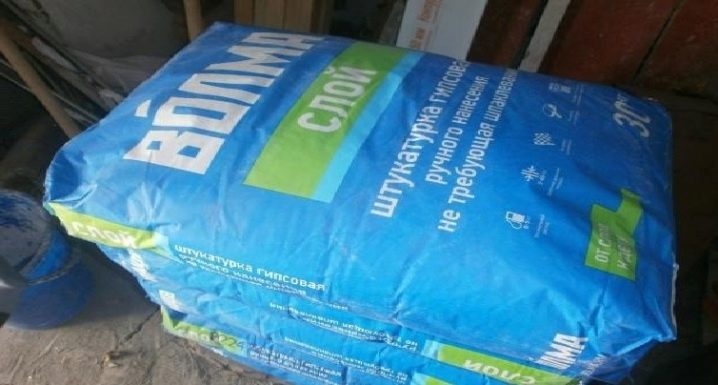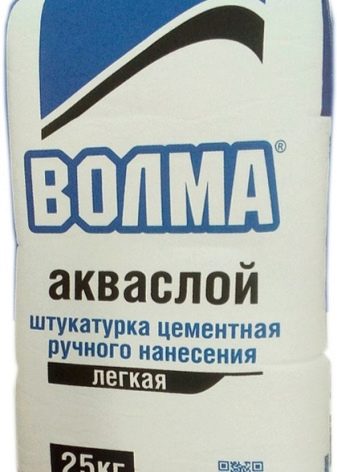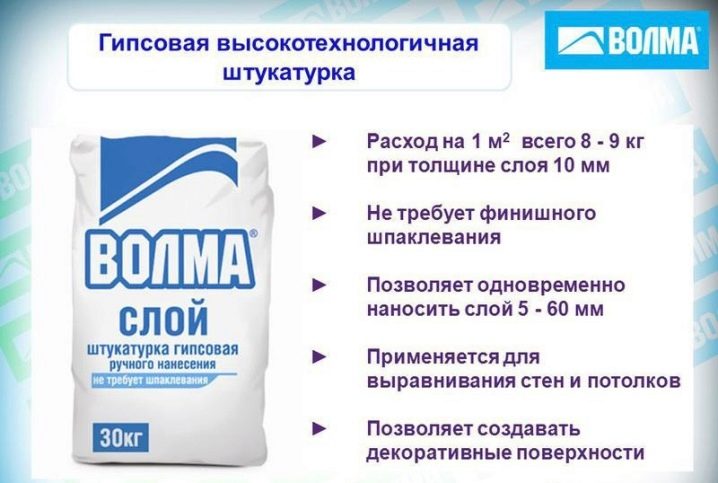Volma plasters: varieties and characteristics

Before you start plastering the walls, you must choose a finishing material. What is the cement plaster mix for Volma walls and what is its consumption per 1 m2 with a layer thickness of 1 cm, as well as reviews of buyers and builders about this plaster, we will consider in one article.
Not a single major overhaul in an apartment is complete without leveling the walls. An excellent and very popular finishing material for these purposes today is the Volma plaster.


The Volma company produces high-quality building finishing materials, among which plaster occupies a special place. Due to its characteristics and properties, plaster surpasses many materials in this category.

Peculiarities
Volma plaster is used to level the walls inside the premises. The main feature of the finishing material is its versatility.
Its composition and properties provide for application to many types of surfaces:
- Concrete walls.

- Plasterboard partitions.

- Cement-lime surface.

- Aerated concrete coatings

- Foam concrete coverings.

- Chipboard surface.

- Brick walls.

As a base, plaster is used for wallpaper, for ceramic tiles, for various types of wall decoration, as well as for painting and filling.
This finishing material has its advantages:
- Ease of application due to the increased plasticity of the material.
- No shrinkage even with thick application layers.
- High degree of adhesion.

- When dry, the treated surface acquires a gloss, so there is no need to apply a finishing putty.
- The composition is natural and does not harm health.

- It is applied to the walls without preliminary preparation, it is enough just to degrease the surface.
- It allows air to pass through, preventing the accumulation of bacteria, and controls the humidity in the room.
- Does not crack or exfoliate even after a while.


There are disadvantages to plaster, but not essential:
- The price segment of the material is above average when compared with products in this category.
- Sometimes large elements are present in the mixture, which, when applied, can spoil the appearance of the surface.

To choose the right finishing material, you need to know its technical characteristics:
- Drying period for Volma plaster is 5-7 days.
- The initial setting moment occurs forty minutes after application.
- The final hardening of the applied solution occurs in three hours.



- The ideal layer thickness is 3 cm, if more is needed, then the process is divided into several stages.
- The maximum seam thickness is 6 cm.
- On average, one kilogram of dry mix requires 0.6 liters of liquid.
- Consumption of plaster with a minimum thickness of the layer is 1 kg per 1 m2, that is, if the layer thickness is 1 mm, then you need 1 kg per m2, if the thickness is 5 mm, then 5 kg per m2.



All Volma plasters, without exception, contain only environmentally friendly ingredients, including mineral components, chemicals and binding elements. The plaster is white and gray.
The assortment of Volma mixes contains solutions for mechanized plastering, machine plastering, as well as solutions for manual plastering of walls.
When buying mixtures for plastering walls, you should pay attention to the shelf life of the material, find out the reviews of experts. And before you start working with the mixture, you must read the description on the package.



Views
Volma plaster is popular both among builders and people who make repairs on their own. The mixture for plastering surfaces is presented in different types and different packaging.
First of all, it is divided into two types:
- The mixture is gypsum.
- The mixture is cement.
For convenience and in order to avoid unnecessary costs during repair work on finishing materials, the manufacturer produces mixtures in packages of 5, 15, 25 and 30 kg. The mixture is intended for finishing walls and ceilings.
The line of finishing materials includes mixtures for hand and machine application. It is necessary to use the finishing material at a given temperature regime (from +5 to +30 degrees) and at a humidity level of at least 5%.


In the arsenal of manufacturers there are different types of mixtures that differ in purpose and method of use:
- Volma-Aquasloy. This is a plaster mixture that is applied to the surface only by machine. It contains light modified aggregates, mineral and synthetic additives, as well as Portland cement - this gives the mixture good physical characteristics. It is used for the alignment of walls indoors and outdoors. Suitable for plastering surfaces in rooms with high humidity.
- Volma-Layer. Suitable for hand plastering of walls and ceilings. There is a variety of this mixture - "Volma-Slay MN", which is used for machine plastering, and can also be found in the stores "Volma-Slay Ultra", "Volma-Slay Titan".


- Volma-Plast. The basis of the mixture is gypsum. It is used as a base when finishing the walls is to be done, that is, finishing plaster, and can also be a finishing material (decorative finish). Due to its composition, this mixture has increased plasticity and a long setting period. Most often used before wallpapering or tiling. The mixture is white, rarely found in pink and green tones.
- Volma-Decor. It has a characteristic distinctive feature - with a certain method of application, it can take on various forms. Forms an excellent decorative layer.
- "Volma-Base". It is a dry mix based on cement. Differs in a unique composition that allows widespread use: levels the foundation, eliminates all surface errors, is used for walls as decoration. It has an increased level of strength, a high protective degree, and it is also moisture resistant and very durable. There is a type used for outdoor work.



In addition to all of the above types, there is "Volma-Gross" based on gypsum, "Volma-Lux" - gypsum for aerated concrete surfaces, "Volma-Aqualux" based on cement, universal.



Consumption
The consumption of this finishing material depends on several factors:
- From the degree of curvature of the surface.
- From the thickness of the layer to be applied.
- From the type of plaster.
If we talk about each separately taken type of Volma plaster, in order to understand the consumption of material, you need to look at the instructions for use.

More accurate calculations will help to make an online construction calculator, which can be found on the Internet. In order for the calculations to be accurate, it is necessary to know the area of the room in which the plastering will be carried out, to understand how thick the plaster will be, what kind of mixture will be used (cement or gypsum), as well as the packaging of the mixture.
For example, the length of the wall is 5 meters, the height is 3 m, the thickness of the layer is assumed to be 30 mm, a gypsum mixture will be used, which is sold in bags of 30 kg. We enter all the data into the calculator table and get the result. So, for plastering, you need 13.5 bags of the mixture.
Examples of consumption for some grades of "Volma" plaster mix:
- Volma-Layer mixture. For 1 m2, you will need from 8 to 9 kg of dry material. The recommended layer of application is from 0.5 cm to 3 cm. Each kilogram of dry material is diluted with 0.6 liters of liquid.

- Volma-Plast mix. One square meter will require 10 kg of dry mix with a layer thickness of 1 cm. The ideal layer thickness is from 0.5 cm to 3 cm. A kilogram of dry mortar will require 0.4 liters of water.
- Volma-Canvas mixture. For plaster of 1 m2, you will need from 9 to 10 kg of dry mortar with a layer of application of 1 cm. The recommended layer of plaster is 0.5 cm - 3 cm. To prepare the solution, 0.65 l of liquid is needed for each kilogram.
- Mix "Volma-Standard". For a kilogram of dry mixture, you need to take 0.45 liters of liquid. The recommended layer of plastering is from 1 mm to 3 mm. Material consumption with a layer thickness of 1 mm is equal to 1 kg.



- Mix "Volma-Base". 1 kg of dry solution is diluted with 200 g of water. With a plaster thickness of 1 cm, you will need 15 kg of dry mix per 1 m2. Recommended bed thickness is maximum 3 cm.
- Mix "Volma-Decor". To prepare 1 kg of finished plaster, you need half a liter of water + 1 kg of dry mix. With a layer thickness of 2 mm, you will need 2 kg of plaster for each square meter.

How to apply?
It is necessary to apply the plaster correctly, otherwise all efforts can be ruined, which means both time and money.
Before plastering, all surfaces must be prepared in advance:
- Carry out cleaning from all kinds of blockages and greasy, oily stains.
- Remove peeled surface areas, clean with a construction tool.
- Dry the surface.


- If there are metal parts on the wall, then they should be treated with anti-corrosion agents.
- To prevent the appearance of mold and mildew, you need to pre-treat the walls with an antiseptic.
- The walls should not be frozen.
- If the surface and type of plaster requires it, then the walls must still be primed before plastering.

To prepare the solution, the required amount of water is poured into a plastic container, preferably at room temperature, or even slightly warmer, then the dry mixture is added. Everything is thoroughly mixed using a construction mixer or other device. The solution should have a homogeneous mass without lumps, resembling thick sour cream.
The solution should stand for several minutes. Then it is whipped again until the small lumps that have appeared are completely eliminated. If the finished mixture spreads, then it is not prepared according to the rules.
You need to dilute exactly as much solution as will be used at a time, otherwise the remainder will have to be thrown away.

Plaster is applied to the surface with a trowel taking into account the required formation thickness. Then the surface is smoothed with a rule. After the first layer of plaster has dried completely, you can start applying another layer. When it grasps and dries up, pruning is performed using the rule. In 20-25 minutes after cutting, the plastered surface is moistened with water and finally smoothed out with a wide spatula. Thus, the walls are ready for wallpapering.
If we are talking about further painting the walls, then one more manipulation is needed - after three hours the plastered walls are again sprayed with abundant liquid and smoothed with the same spatula or a hard float. The result is a perfectly flat and glossy wall. Each solution has its own drying time. Some solution dries faster, and some slower. All detailed information can be found on the packaging. The surfaces are completely dry for one week.


If there is decoration on the plaster, then additional construction tools (roller, trowel, brush, sponge float) will be needed for the pattern or drawing.
Recommendations for use
In order for the plastering of the walls to be successful, you need not only to follow all the rules, but also to listen to the advice and recommendations of the masters:
- The finished solution dries up within 20 minutes, so you need to cook it in small portions.
- Do not use gypsum plaster in rooms with high humidity, as this can lead to swelling or flaking of the solution.


- A poorly cleaned surface significantly reduces the degree of adhesion of the solution.
- Before wallpapering or painting plastered walls, make sure they are completely dry.
In the next video you will see a master class on the application of Volma-Layer gypsum plaster.













The comment was sent successfully.